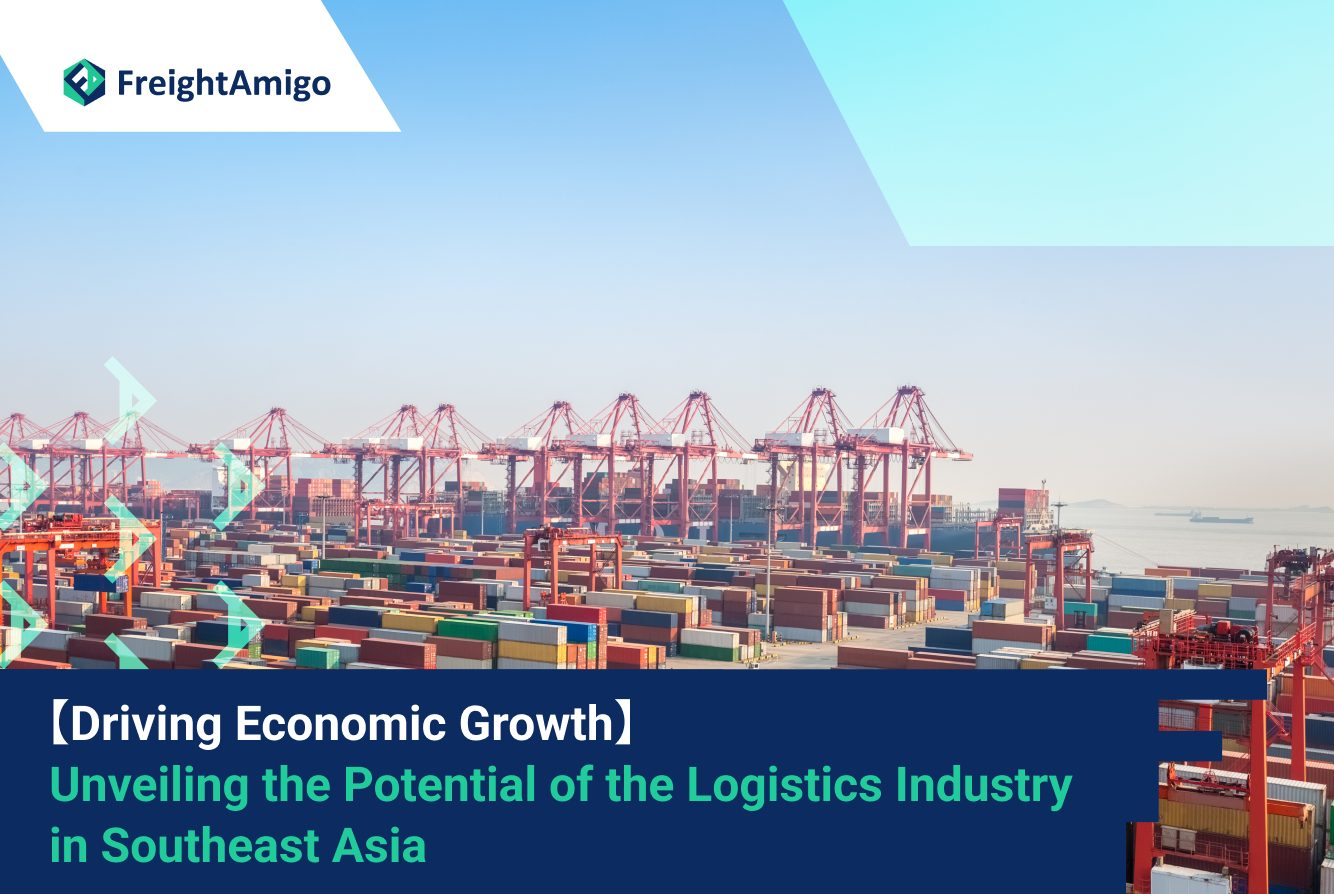Author Name: Tiffany Lee – Marketing Analyst at FreightAmigo
The logistics industry in Southeast Asia is experiencing significant growth, driven by the expanding economies, manufacturing sectors, and the rise of e-commerce. The region’s strategic location, improving infrastructure, and favorable government policies have made it an attractive destination for investment in the logistics sector. In this article, we will explore the economic benefits of the logistics industry in Southeast Asia, the key drivers behind its growth, and the opportunities it presents.
Want To Compare The Best Express, Air Freight, Sea Freight, Rail Freight & Trucking Rates So As To Have Better Control On Cost?
Southeast Asia’s Booming Economy
Southeast Asia is currently in a favorable economic position, offering a “sweet spot” for logistics industry growth. Despite the impact of the global economic slowdown, the region is cushioned by the ongoing supply chain shift from China to Southeast Asia. This shift has mitigated the impact of the slowdown and has attracted significant investment to the region.
The region’s expanding middle class, increasing urbanization rates, and strong population growth have driven domestic demand and consumption of goods. This growth in domestic demand has created a solid foundation for the expansion of the modern logistics sector, with a particular emphasis on meeting the needs of the booming e-commerce industry.
The Rise of E-commerce
The rapid adoption of e-commerce in Southeast Asia has been a major driver of growth in the logistics industry. The region has witnessed a significant increase in internet penetration rates, leading to a shift in consumer behavior and a surge in online shopping. As a result, the demand for efficient logistics services to support e-commerce activities has skyrocketed.
Southeast Asia, with its population of over 650 million people, reached 370 million internet users in 2018. This growing digital market is forecasted to reach US$240 billion by 2025. The logistics industry has responded to this demand by expanding its operations in developing markets, improving last-mile delivery capabilities, and investing in technology to enhance efficiency.
Infrastructure Development and Connectivity
Infrastructure development is a critical factor in driving the growth of the logistics industry in Southeast Asia. The region has recognized the importance of improving its transportation networks, including aviation, maritime, and road infrastructure, to support the movement of goods across borders.
The Asian Highway Master Plan has played a significant role in building an effective road network throughout the region, reducing bottlenecks, and enhancing connectivity. Southeast Asian countries have also invested in the development of rail transportation to create a more integrated network, connecting the region with China.
Furthermore, the region’s strategic location and extensive coastline have made it an ideal hub for maritime transport. With major seaports in countries like Singapore, Malaysia, and Vietnam, Southeast Asia has become a crucial trade center, attracting investments and facilitating the movement of goods through its advanced seaport infrastructure.
Manufacturing Hub and Supply Chain Diversification
Southeast Asia has emerged as a major manufacturing hub, attracting companies looking to diversify their supply chains away from China. The US-China trade war and the impact of the COVID-19 pandemic have accelerated this trend, prompting businesses to relocate their operations to countries like Vietnam, Thailand, and Indonesia.
Vietnam, in particular, has experienced significant growth in its manufacturing sector, becoming a preferred destination for foreign manufacturers due to its low labor costs and favorable business environment. The government’s efforts to establish economic zones and industrial parks have further enhanced its attractiveness as a manufacturing and logistics hub.
The diversification of supply chains has created new opportunities for the logistics industry in Southeast Asia. Companies are investing in logistics operations to support the movement of goods from manufacturing facilities to distribution centers and ultimately to the end consumers.
Trade Agreements and Market Integration
Southeast Asian countries have actively pursued trade agreements and market integration initiatives to promote economic growth and facilitate cross-border trade. The region’s participation in free trade agreements, such as the ASEAN Free Trade Area (AFTA) and the Regional Comprehensive Economic Partnership (RCEP), has opened up new opportunities for businesses and increased trade volumes.
These trade agreements have reduced trade barriers, lowered tariffs, and simplified customs procedures, making it easier for companies to engage in international trade. This has created a conducive environment for the logistics industry to thrive, as it plays a crucial role in facilitating the movement of goods across borders and ensuring efficient supply chains.
Opportunities for Innovation and Technological Advancements
The growth of the logistics industry in Southeast Asia has created opportunities for innovation and technological advancements. As the demand for logistics services increases, companies are investing in technologies to improve operational efficiency, enhance tracking and visibility, and optimize supply chain management.
Technological solutions such as warehouse management systems (WMS), transport management systems (TMS), and advanced tracking technologies have become essential tools for logistics providers. These technologies enable real-time monitoring of shipments, streamline inventory management, and improve overall operational efficiency.
Additionally, the rise of e-commerce has fueled the demand for last-mile delivery solutions, prompting the development of innovative delivery models and the use of autonomous vehicles and drones for efficient and timely deliveries.
Sustainable and Green Logistics Practices
As the logistics industry grows in Southeast Asia, there is an increasing focus on sustainable and green logistics practices. The region has recognized the importance of reducing carbon emissions, improving energy efficiency, and minimizing the environmental impact of logistics operations.
Companies are investing in green technologies, using renewable energy sources, and adopting sustainable transportation practices to reduce their carbon footprint. Governments are also implementing regulations and incentives to encourage the adoption of sustainable logistics practices, such as the promotion of electric vehicles and the development of eco-friendly infrastructure.
Outlook and Potential Roadblocks
The outlook for the logistics industry in Southeast Asia remains positive, with continued growth expected in the coming years. The region’s expanding economies, rising middle class, and increasing urbanization rates will continue to drive demand for logistics services.
However, there are potential roadblocks that need to be addressed to ensure sustained growth. These include the need for further infrastructure development, improvements in customs procedures, and the implementation of standardized regulations across the region. Additionally, the logistics industry must keep pace with technological advancements and invest in talent development to meet the evolving needs of the market.
Conclusion
The logistics industry in Southeast Asia is experiencing significant growth, driven by the region’s expanding economies, manufacturing sectors, and the rise of e-commerce. The strategic location of Southeast Asia, improving infrastructure, and government support have made it an attractive destination for investment in the logistics sector.
The industry presents numerous opportunities for innovation, technological advancements, and sustainable practices. However, challenges exist, particularly for SMEs, in competing with larger players in the market. Government support, infrastructure development, and standardized regulations are crucial in ensuring sustained growth and competitiveness in the industry.
With its favorable economic conditions, growing consumer demand, and increasing connectivity, Southeast Asia is poised to continue its trajectory as a leading logistics hub in the global market. As the region continues to attract investment and foster innovation, the economic benefits of the logistics industry in Southeast Asia are expected to expand further, driving overall economic growth and development.
There Are Different Options For Cargo Transportation. If You Want To Choose The Most Convenient And Suitable Solution, It Is Best To Have The Full Support Of Logistics Experts! If You Are Planning To Ship Goods Overseas, Please Go To The FreightAmigo Page For Inquiries.
===
Read More:
【Cosmetic Product Recycling】 A Guide to Sustainable Reverse Logistics
【Rise of Green Supply Chain】 Pioneering Sustainable Practices in Logistics
【ESG in Logistics】 How ESG Practices Drive Social Responsibility in Logistics
===
If you have any inquiries on logistics/supply chain, feel free to contact FreightAmigo now:
Chat with us online OR
Phone : +852 28121686
WhatsApp: +852 27467829










































